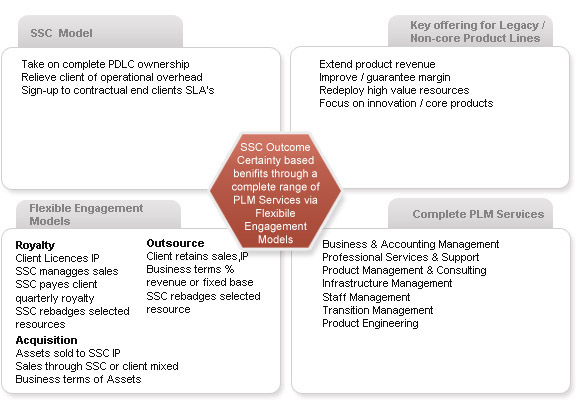Product Lifecycle Management
Industry analysts estimate that up to 80% of R&D; budgets are allocated to maintaining
legacy products. But, older products are vulnerable to competitive pressures, yielding
decreased revenue and margins. Moreover, a lopsided resource allocation to older
products significantly limits a company’s ability to work on the next generation
of products that could leverage high-growth market opportunities.
| BMC Software |
 |
|
 |
| |
"The joint-development and incentive-based nature of our agreement with Symphony provides a strong advantage in the marketplace for BMC. Our customers will benefit from continued product innovation through co-development with a leading services organization, and BMC will maximize the business performance of selected products that are entering the mature stage of their life-cycle."
Dayon Kane
General Manager, BMC Legacy Product Business Unit |
| |
|
With a shrinking product investment window, a firm’s investment in its client base declines and eventually, enterprise clients migrate away due to poor support strategies around non-core products.
So, how can companies buck the trend and focus their energies and investments on
new products for long-term market viability and higher R&D; returns? How can they
counter-balance the shifting investments towards new growth areas so as to prevent
clients from forsaking the impacted legacy products, straining relationships and
disrupting revenues?
Symphony’s PLM Offering
Symphony Services’ Product Lifecycle Management (PLM) Services offer product companies
alternatives to manage the de-investment in mature products and drive transformation.
Symphony Services takes on end-to-end responsibility for selected products and product
lines, from full PDLC and support services to sales and operational activities,
all aligned against agreed-upon SLAs and using a global delivery model to reduce
the cost of operations. Symphony’s offering is in sync with industry-recognized
PLM best practices (Forrester Report, April 2009) that keep programs manageable,
drive collaboration across the development process and integrate to downstream applications.
Through a diverse set of outcome-based PLM engagement models that enable clients
to either retain revenues or focus on pure margins or maximize cash, Symphony guarantees
the alignment of delivery to client’s business objectives.

How does Symphony do it?
- Symphony Services’ development team’s patented, repeatable processes begins with
a careful assessment of clients’ PLM needs to ensure its services are perfectly
aligned with the organization’s business goals.
- Symphony assumes full accountability for all aspects of the PDLC and business operation
for targeted products. It assumes all contractual SLAs.
- Every product function is measured and analyzed for continuous product improvement
Key subject matter experts are reallocated.
- Budget and resource management is optimized through global delivery.
Symphony Services’ PLM services mitigate the challenge of having too many R&D; resources
committed to legacy product lines, when their time and expertise are better spent
developing new products to ensure the company stays ahead of evolving market demand.
Delivering Key Benefits to Clients
Symphony Services’ outcome-driven solutions are backed by SLAs. The company has,
on average, reduced clients’ product management costs by over 25 percent; extended
product life related revenue by up to 50 percent; and lowered support costs by 40
percent – all without sacrificing on outcomes.
Partner with Symphony
Symphony’s long-standing experience with PLM engagements is testimony to the fact
that it is committed to providing the most innovative PLM services available that
enable clients to maximize their legacy product potential. If you would like to
talk about this further, please contact us at [email protected]